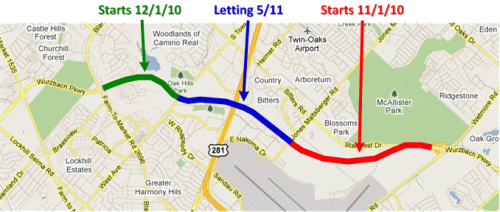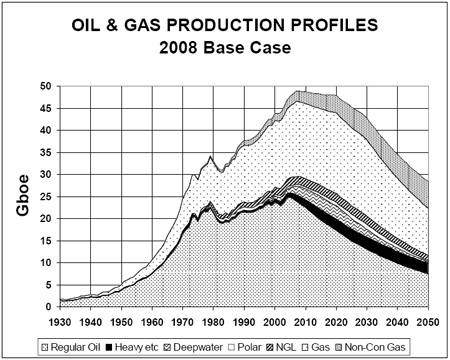Construction and closures Roads: stimulus funds Texas Department of Transportation US 281 Wurzbach Parkway
by Brian
4 comments
Construction starting next week on Wurzbach Pkwy

TxDOT announced today that work will start next week on the first of three phases to finally complete the Wurzbach Parkway. Crews will begin November 1st on the section from Wetmore to Jones-Maltsberger, with completion expected in early 2014. A month later, on December 1st, work is scheduled to begin on the segment from Blanco Rd. to West Ave. That section should be done about a year sooner, in early 2013.
That leaves the final section from West Ave. to Jones-Maltsberger. That stretch is scheduled to go to bid in May of next year.
All three sections will feature a four-lane divided parkway similar to that already in-place east of Wetmore. Despite earlier uncertainty over costs, it appears now that the projects will include overpasses at Blanco, West Ave., US 281, Jones-Maltsberger, and Starcrest. However, there still are no plans at this time for a full interchange at US 281.
The total cost of all three segments is expected to be around $130 million and is being funded with Proposition 12 funds approved by the Texas Transportation Commission (TTC) about a year ago. Officials had originally hoped to get federal stimulus funds for the project, but when that didn’t materialize, the TTC took advantage of new Prop 12 funds authorized by the Legislature. The Wurzbach project was the largest single Prop 12 project approved last year.
Construction and closures Roads: De Zavala Jones-Maltsberger railroad crossing stimulus funds US 281 widening
by Brian
1 comment
Work wrapping up at the Quarry, starting on De Zavala
Crews opened all the new lanes on Jones-Maltsberger at the railroad tracks by the Quarry this past weekend. Finish-up work should be completed by Thanksgiving, just in time for the Christmas shopping frenzy. As you may recall, work began there earlier this year to finally remove the long-standing bottleneck between the Quarry and US 281. Work was expected to be finished last month, but this year’s unusual rain delayed things just a bit.
Meanwhile, work began last month on a long-awaited (or maybe long-feared) project to widen De Zavala between Babcock and Cogburn. The project will widen the road to five lanes (two each way plus a center left-turn lane) and add sidewalks, curbs, and updated traffic signals. The $17 million project is expected to be completed in mid 2012.
Oil and gas prices: peak oil
by Patrick
Comments Off on More on “peak oil” and economic decline
More on “peak oil” and economic decline
Think back to the oil shocks of 1973 and 1979.
The economic crashes back then are just a taste of what’s coming in two to five years, energy analyst Robert Hirsch told a conference Friday in San Antonio, according to the Express-News.
That’s when Hirsch estimates the world will reach peak oil production. After that, supplies will decline.
It’s going to be chaos, the story described. And this time the recession will be much longer and tougher to turn around.
“There will be no quick fixes,” Hirsch said.
Hirsch first rang the warning in a 2005 report he did for the U.S. Department of Energy. He and two other authors have followed up with the “The Impending World Energy Mess,” a book released this month. Read more in this post.
Oil and gas prices: peak oil
by Patrick
Comments Off on What “peak oil” could mean to you
What “peak oil” could mean to you
Peak oil.
There it is. A rather nondescript phrase that, when plugged into Google, calls up a mountain of angst and controversy.
Peak oil is the apex of production, when new field discoveries and technologies just can’t recover as much oil as we once did. The U.S. passed peak production in the 1970s. Some say we’re passing the global peak now, or about to.
The implications are huge.
Millions of years worth of energy have been stored in a compact and portable form to give us oil. Unleashed a century ago, the black gooeyness had a lot to do with transforming and buoying our modern economy and way of life.
Are there enough energy alternatives to replace black gold? Can we mitigate in time to avoid economic disaster?

